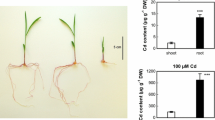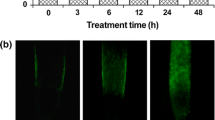Abstract
Main conclusion
NBT and HE may be efficiently used for the detection of superoxide, while DCDHF-DA and DHR123 for the detection of peroxynitrite in intact barley root tips, only if PRXs and oxidoreductases are inhibited to avoid false-positive reactions.
Abstract
Strong peroxidase (PRX) and oxidoreductase activities were observed in the barley root tips that were markedly inhibited by NaN3. Rapid and strong nitro-blue tetrazolium chloride (NBT) reduction is associated mainly with the vital functions of root cells but not with superoxide formation. In turn, the inhibition of root surface redox activity by NaN3 strongly reduced the formation of formazan, but its slight accumulation, observed in the root elongation zone, was a result of NADPH oxidase-mediated apoplastic superoxide formation. A longer staining time period with NBT was required for the detection of antimycin A-mediated superoxide formation inside the cells. This antimycin A-induced superoxide was clearly detectable by hydroethidine (HE) after the inhibition of PRXs by NaN3, and it was restricted into the root transition zone. TEMPOL, a superoxide scavenger, strongly inhibited both NBT reduction and HE oxidation in the presence of NaN3. Similarly, the DCDHF-DA and DHR123 oxidation was markedly reduced after the inhibition of apoplastic PRXs by NaN3 and was detectable mainly in the root transition zone. This fluorescence signal was not influenced by the application of pyruvate but was strongly reduced by urea, a peroxynitrite scavenger. The presented results suggest that if the root PRXs and oxidoreductases are inhibited, both NBT and HE detect mainly superoxide, whereas both DCDHF-DA and DHR123 may be efficiently used for the detection of peroxynitrite in intact barley root tips. The inhibition of PRXs and oxidoreductases is crucial for avoiding false-positive reactions in the localization of reactive oxygen species in the intact barley root tip.








Similar content being viewed by others
Data availability
All data generated or analyzed during this study are included in this published article.
Abbreviations
- DCDHF-DA:
-
2,7-Dichlorodihydrofluorescein diacetate
- DHR123:
-
Dihydrorhodamine 123
- HE:
-
Hydroethidine
- NBT:
-
Nitro-blue tetrazolium chloride
- NOX:
-
NADPH oxidase
- PRX:
-
Peroxidase
- ROS:
-
Reactive oxygen species
References
Able AJ, Guest DI, Sutherland MW (1998) Use of a new tetrazolium-based assay to study the production of superoxide radicals by tobacco cell cultures challenged with avirulent zoospores of Phytophthora parasitica var nicotianae. Plant Physiol 117:491–499. https://doi.org/10.1104/pp.117.2.491
Amtmann A, Jelitto TC, Sanders D (1999) K+-selective inward-rectifying channels and apoplastic pH in barley roots. Plant Physiol 119:331–338. https://doi.org/10.1104/pp.120.1.331
Baker MA, Krutskikh A, Curry BJ, McLaughlin EA, Aitken RJ (2004) Identification of cytochrome P450-reductase as the enzyme responsible for NADPH-dependent lucigenin and tetrazolium salt reduction in rat epididymal sperm preparations. Biol Reprod 71:307–318. https://doi.org/10.1095/biolreprod.104.027748
Beauchamp C, Fridovich I (1971) Superoxide dismutase: improved assays and an assay applicable to acrylamide gels. Anal Biochem 44:276–287. https://doi.org/10.1016/0003-2697(71)90370-8
Beigrezaei S, Nasri H (2017) Tempol as an antioxidant; an updated review on current knowledge. Ann Res Antioxid 2:e01
Benov L, Sztejnberg L, Fridovich I (1998) Critical evaluation of the use of hydroethidine as a measure of superoxide anion radical. Free Radic Biol Med 25:826–831. https://doi.org/10.1016/s0891-5849(98)00163-4
Bérczi A, Møller IM (2000) Redox enzymes in the plant plasma membrane and their possible roles. Plant Cell Environ 23:1287–1302. https://doi.org/10.1046/j.1365-3040.2000.00644.x
Berridge MV, Herst PM, Tan AS (2005) Tetrazolium dyes as tools in cell biology: new insights into their cellular reduction. Biotechnol Annu Rev 11:127–152. https://doi.org/10.1016/S1387-2656(05)11004-7
Burnaugh L, Sabeur K, Ball BA (2007) Generation of superoxide anion by equine spermatozoa as detected by dihydroethidium. Theriogenology 67:580–589. https://doi.org/10.1016/j.theriogenology.2006.07.021
Crow JP (1997) Dichlorodihydrofluorescein and dihydrorhodamine 123 are sensitive indicators of peroxynitrite in vitro: implications for intracellular measurement of reactive nitrogen and oxygen species. Nitric Oxide 1:145–157. https://doi.org/10.1006/niox.1996.0113
de Souza AJ, Pauly M (2015) Comparative genomics of pectinacetylesterases: insight on function and biology. Plant Signal Behav 10:e1055434. https://doi.org/10.1080/15592324.2015.1055434
Demecsová L, Bočová B, Zelinová V, Tamás L (2019) Enhanced nitric oxide generation mitigates cadmium toxicity via superoxide scavenging leading to the formation of peroxynitrite in barley root tip. J Plant Physiol 238:20–28. https://doi.org/10.1016/j.jplph.2019.05.003
Dunand C, Crèvecoeur M, Penel C (2007) Distribution of superoxide and hydrogen peroxide in Arabidopsis root and their influence on root development: possible interaction with peroxidases. New Phytol 174:332–341. https://doi.org/10.1111/j.1469-8137.2007.01995.x
Foreman J, Demidchik V, Bothwell JHF, Mylona P, Miedema H, Torres MA, Linstead P, Costa S, Brownlee C, Jones JDG, Davies JM, Dolan L (2003) Reactive oxygen species produced by NADPH oxidase regulate plant cell growth. Nature 422:442–446. https://doi.org/10.1038/nature01485
Francoz E, Ranocha P, Nguyen-Kim H, Jamet E, Burlat V, Dunand C (2015) Roles of cell wall peroxidases in plant development. Phytochemistry 112:15–21. https://doi.org/10.1016/j.phytochem.2014.07.020
Georgiou CD, Papapostolou I, Grintzalis K (2008) Superoxide radical detection in cells, tissues, organisms (animals, plants, insects, microorganisms) and soils. Nat Protoc 3:1679–1692. https://doi.org/10.1038/nprot.2008.155
Gomes A, Fernandes E, Lima JLFC (2005) Fluorescence probes used for detection of reactive oxygen species. J Biochem Biophys Methods 65:45–80. https://doi.org/10.1016/j.jbbm.2005.10.003
Gülçin I, Oktay M, Köksal E, Serbetci H, Beydemir S, Küfrevioglu ÖI (2008) Antioxidant and radical scavenging activities of uric acid. Asian J Chem 20:2079–2090
Henderson LM, Chappell JB (1993) Dihydrorhodamine 123: a fluorescent probe for superoxide generation? Eur J Biochem 217:973–980. https://doi.org/10.1111/j.1432-1033.1993.tb18328.x
Kooy NW, Royall JA, Ischiropoulos H, Beckman JS (1994) Peroxynitrite-mediated oxidation of dihydrorhodamine 123. Free Radic Biol Med 16:149–156. https://doi.org/10.1016/0891-5849(94)90138-4
Kováčik J, Babula P (2017) Fluorescence microscopy as a tool for visualization of metal-induced oxidative stress in plants. Acta Physiol Plant 39:157. https://doi.org/10.1007/s11738-017-2455-0
Ma Z, Liu J, Dong J, Yu J, Huang S, Lin H, Hu S, Wang J (2019) Optimized qualitative and quantitative methods for barley viability testing using triphenyl tetrazolium chloride staining. Cereal Chem 96:421–428. https://doi.org/10.1002/cche.10141
Marino D, Dunand C, Puppo A, Pauly N (2012) A burst of plant NADPH oxidases. Trends Plant Sci 17:9–15. https://doi.org/10.1016/j.tplants.2011.10.001
Mattson AM, Jensen CO, Dutcher RA (1947) Triphenyltetrazolium chloride as a dye for vital tissues. Science 26:294–295. https://doi.org/10.1126/science.106.2752.294.b
Meany DL, Poe BG, Navratil M, Moraes CT, Arriaga EA (2006) Superoxide released into the mitochondrial matrix. Free Radic Biol Med 41:950–959. https://doi.org/10.1016/j.freeradbiomed.2006.06.003
Mhamdi A, Van Breusegem F (2018) Reactive oxygen species in plant development. Development 145:dev164376. https://doi.org/10.1242/dev.164376
Mignolet-Spruyt L, Xu E, Idänheimo N, Hoeberichts FA, Mühlenbock P, Brosché M, Van Breusegem F, Kangasjärvi J (2016) Spreading the news: subcellular and organellar reactive oxygen species production and signalling. J Exp Bot 67:3831–3844. https://doi.org/10.1093/jxb/erw080
Misra HP, Fridovich I (1978) Inhibition of superoxide dismutases by azide. Arch Biochem Biophys 189:317–322. https://doi.org/10.1016/0003-9861(78)90218-7
Mittler R (2017) ROS are good. Trends Plant Sci 22:11–19. https://doi.org/10.1016/j.tplants.2016.08.002
Monshausen GB, Bibikova TN, Messerli MA, Shi C, Gilroy S (2007) Oscillations in extracellular pH and reactive oxygen species modulate tip growth of Arabidopsis root hairs. Proc Natl Acad Sci USA 104:20996–21001. https://doi.org/10.1073/pnas.0708586104
Myhre O, Andersen JM, Aarnes H, Fonnum F (2003) Evaluation of the probes 2′,7′-dichlorofluorescin diacetate, luminol, and lucigenin as indicators of reactive species formation. Biochem Pharmacol 65:1575–1582. https://doi.org/10.1016/s0006-2952(03)00083-2
Noctor G, De Paepe R, Foyer CH (2007) Mitochondrial redox biology and homeostasis in plants. Trends Plant Sci 12:125–134. https://doi.org/10.1016/j.tplants.2007.01.005
Ortega-Villasante C, Burén S, Blázquez-Castro A, Barón-Sola Á, Hernández LE (2018) Fluorescent in vivo imaging of reactive oxygen species and redox potential in plants. Free Radic Biol Med 122:202–220. https://doi.org/10.1016/j.freeradbiomed.2018.04.005
Ortiz de Montellano PR, David SK, Ator MA, Tew D (1988) Mechanism-based inactivation of horseradish peroxidase by sodium azide. Formation of meso-azidoprotoporphyrin IX. Biochemistry 27:5470–5476. https://doi.org/10.1021/bi00415a013
Padiglia A, Medda R, Longu S, Pedersen JZ, Floris G (2002) Uric acid is a main electron donor to peroxidases in human blood plasma. Med Sci Monit 8:BR454–BR459
Passardi F, Penel C, Dunand C (2004) Performing the paradoxical: how plant peroxidases modify the cell wall. Trends Plant Sci 9:534–540. https://doi.org/10.1016/j.tplants.2004.09.002
Pasternak TP, Perez-Perez JM (2021) Optimization of ROS measurement and localization in plant tissues: challenges and solutions. https://doi.org/10.17504/protocols.io.bx49pqz6
Patsoukis N, Papapostolou I, Georgiou CD (2005) Interference of non-specific peroxidases in the fluorescence detection of superoxide radical by hydroethidine oxidation: a new assay for H2O2. Anal Bioanal Chem 381:1065–1072. https://doi.org/10.1007/s00216-004-2999-x
Possel H, Noack H, Augustin W, Keilhoff G, Wolf G (1997) 2,7-Dihydrodichlorofluorescein diacetate as a fluorescent marker for peroxynitrite formation. FEBS Lett 416:175–178. https://doi.org/10.1016/s0014-5793(97)01197-6
Radi R, Peluffo G, Alvarez MN, Naviliat M, Cayota A (2001) Unraveling peroxynitrite formation in biological systems. Free Radic Biol Med 30:463–488. https://doi.org/10.1016/s0891-5849(00)00373-7
Reczek CR, Chandel NS (2015) ROS-dependent signal transduction. Curr Opin Cell Biol 33:8–13. https://doi.org/10.1016/j.ceb.2014.09.010
Robinson KM, Janes MS, Pehar M, Monette JS, Ross MF, Hagen TM, Murphy MP, Beckman JS (2006) Selective fluorescent imaging of superoxide in vivo using ethidium-based probes. Proc Natl Acad Sci USA 103:15038–15043. https://doi.org/10.1073/pnas.0601945103
Romero-Puertas MC, Rodríguez-Serrano M, Corpas FJ, Gómez M, Del Río LA, Sandalio LM (2004) Cadmium-induced subcellular accumulation of O2.− and H2O2 in pea leaves. Plant Cell Environ 27:1122–1134. https://doi.org/10.1111/j.1365-3040.2004.01217.x
Sandalio LM, Rodríguez-Serrano M, Romero-Puertas MC, Del Río LA (2008) Imaging of reactive oxygen species and nitric oxide in vivo in plant tissues. Methods Enzymol 440:397–409. https://doi.org/10.1016/S0076-6879(07)00825-7
Squadrito GL, Cueto R, Splenser AE, Valavanidis A, Zhang H, Uppu RM, Pryor WA (2000) Reaction of uric acid with peroxynitrite and implications for the mechanism of neuroprotection by uric acid. Arch Biochem Biophys 376:333–337. https://doi.org/10.1006/abbi.2000.1721
Thordal-Christensen H, Zhang Z, Wei Y, Collinge DB (1997) Subcellular localization of H2O2 in plants. H2O2 accumulation in papillae and hypersensitive response during the barley-powdery mildew interaction. Plant J 11:1187–1194. https://doi.org/10.1046/j.1365-313X.1997.11061187.x
Van Aken O (2021) Mitochondrial redox systems as central hubs in plant metabolism and signaling. Plant Physiol 186:36–52. https://doi.org/10.1093/plphys/kiab101
Welinder KG, Justesen AF, Kjærsgård IVH, Jensen RB, Rasmussen SK, Jespersen HM, Duroux L (2002) Structural diversity and transcription of class III peroxidases from Arabidopsis thaliana. Eur J Biochem 269:6063–6081. https://doi.org/10.1046/j.1432-1033.2002.03311.x
Zhao H, Kalivendi S, Zhang H, Joseph J, Nithipatikom K, Vásquez-Vivar J, Kalyanaraman B (2003) Superoxide reacts with hydroethidine but forms a fluorescent product that is distinctly different from ethidium: potential implications in intracellular fluorescence detection of superoxide. Free Radic Biol Med 34:1359–1368. https://doi.org/10.1016/s0891-5849(03)00142-4
Zielonka J, Kalyanaraman B (2010) Hydroethidine- and MitoSOX-derived red fluorescence is not a reliable indicator of intracellular superoxide formation: another inconvenient truth. Free Radic Biol Med 48:983–1001. https://doi.org/10.1016/j.freeradbiomed.2010.01.028
Zielonka J, Vasquez-Vivar J, Kalyanaraman B (2008) Detection of 2-hydroxyethidium in cellular systems: a unique marker product of superoxide and hydroethidine. Nat Protoc 3:8–21. https://doi.org/10.1038/nprot.2007.473
Acknowledgements
This work was supported by the Grant Agency VEGA, Project No. 2/0039/20. The authors would also like to thank the anonymous reviewers for their helpful criticisms, who improved the manuscript.
Author information
Authors and Affiliations
Corresponding author
Ethics declarations
Conflict of interest
The authors declare that there are no conflicts of interest.
Additional information
Communicated by Dorothea Bartels.
Publisher's Note
Springer Nature remains neutral with regard to jurisdictional claims in published maps and institutional affiliations.
Rights and permissions
About this article
Cite this article
Valentovičová, K., Demecsová, L., Liptáková, Ľ. et al. Inhibition of peroxidases and oxidoreductases is crucial for avoiding false-positive reactions in the localization of reactive oxygen species in intact barley root tips. Planta 255, 69 (2022). https://doi.org/10.1007/s00425-022-03850-1
Received:
Accepted:
Published:
DOI: https://doi.org/10.1007/s00425-022-03850-1




